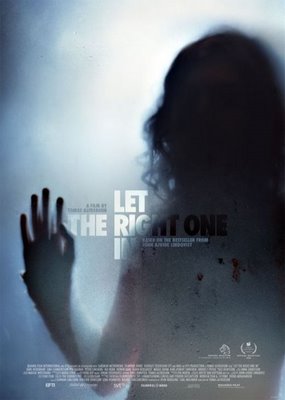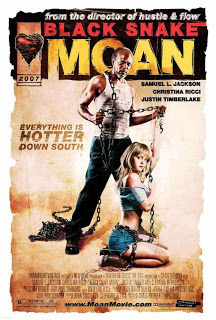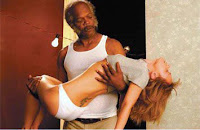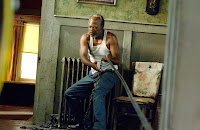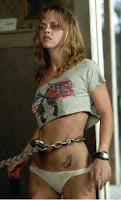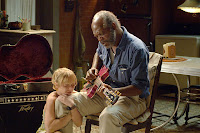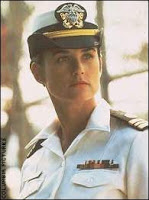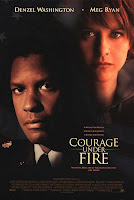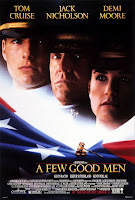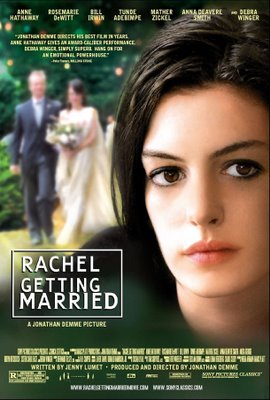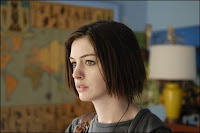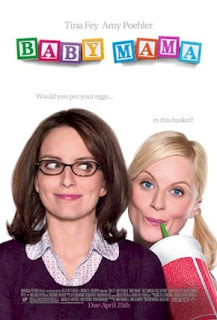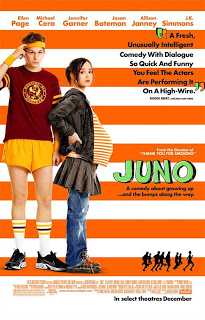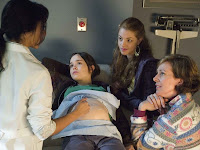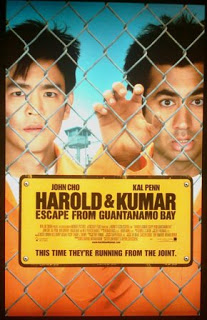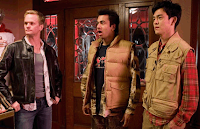Let the Right One In. Starring Kare Hedebrant, Lina Leandersson, Per Ragnar, Henrik Dahl, Karin Bergquist, Peter Carlberg, and Ika Nord. Written by John Ajvide Lindqvist. Directed by Tomas Alfredson.
I want to describe Let the Right One In as a vampire love story, but that wouldn’t nearly do it justice. That description wouldn’t, however, be entirely inaccurate either. The mov ie’s protagonist is a twelve-year-old boy named Oskar who lives in the Stockholm suburb of Blackeberg in 1982. We first encounter him pretending to defend himself against the school bullies who constantly berate him, but the reality is he doesn’t yet know how to stand up to them. Instead, he collects newspaper clippings of violent crimes and secretly files them away in a notebook, almost as revenge-fantasies. He sleeps with a knife and carries it with him everywhere, and the night he stands outside in the freezing cold, stabbing a tree while calling it “piggy” (the school bullies’ nickname for him), he encounters Eli.
ie’s protagonist is a twelve-year-old boy named Oskar who lives in the Stockholm suburb of Blackeberg in 1982. We first encounter him pretending to defend himself against the school bullies who constantly berate him, but the reality is he doesn’t yet know how to stand up to them. Instead, he collects newspaper clippings of violent crimes and secretly files them away in a notebook, almost as revenge-fantasies. He sleeps with a knife and carries it with him everywhere, and the night he stands outside in the freezing cold, stabbing a tree while calling it “piggy” (the school bullies’ nickname for him), he encounters Eli.
Eli appears out of nowhere behind their shared apartment building, watching Oskar. She’s got wide, creepy eyes, and Oskar tells her she smells funny. He also wonders why she isn’t cold, since she’s wearing only a t-shirt and standing in the snow barefoot. These questions hardly get resolved; when he asks her why she isn’t cold, she says, “I guess I’ve forgotten how.” They both leave their first meeting declaring that they don’t want to be friends, and that declaration more or less showcases just how “other” each of the characters feels—it’s easier to remain alone than to risk yet another person’s contempt.
It isn’t clear 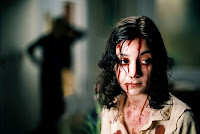 whether Hakan, the man who lives with Eli, is her father or her familiar. (In vampire myth, a familiar is a human who wishes to become a vampire by signing with the vampires through a blood oath.) Regardless, Hakan acts as Eli’s caretaker by slinking through the streets of Blackeberg in the middle of the night in search of a human to drain for blood. In each of his attempts, he screws up, and it provides several instances of black comedy in the film. But when Hakan can’t get the blood Eli needs to survive, she’s forced to go find it herself.
whether Hakan, the man who lives with Eli, is her father or her familiar. (In vampire myth, a familiar is a human who wishes to become a vampire by signing with the vampires through a blood oath.) Regardless, Hakan acts as Eli’s caretaker by slinking through the streets of Blackeberg in the middle of the night in search of a human to drain for blood. In each of his attempts, he screws up, and it provides several instances of black comedy in the film. But when Hakan can’t get the blood Eli needs to survive, she’s forced to go find it herself.
Watching such a small girl ravenously and violently latch onto a man who attempts to help her (she calls out to him, pretending she’s hurt, then buries her face and teeth into his neck), well, I jumped in my seat. It’s scary. And just as the audience begins to understand that, omg, she really is a vampire! she breaks her victim’s neck and leans over him sadly, almost apologetically, creating one of the many beautiful scene juxtapositions in the film, first exposing Eli as animal, then immediately highlighting her humanity. She kills because she needs to kill, not because she wants to.
From this moment on, the movie tackles several themes, one of which is violence, specifically the kid-on-kid viole nce Oskar experiences at the hands of his classmates, and how that plays against the vampire-on-human violence Eli’s responsible for. What does it say, for instance, that Eli, a killer by definition, experiences remorse for a necessary act of violence, while a group of young boys, most notably the leader of the pack, gets off on torturing and humiliating Oskar? As Eli and Oskar’s friendship develops, Eli ultimately convinces Oskar to stand up to the school bullies, and the consequences of his actions set the stage for the film’s finale.
nce Oskar experiences at the hands of his classmates, and how that plays against the vampire-on-human violence Eli’s responsible for. What does it say, for instance, that Eli, a killer by definition, experiences remorse for a necessary act of violence, while a group of young boys, most notably the leader of the pack, gets off on torturing and humiliating Oskar? As Eli and Oskar’s friendship develops, Eli ultimately convinces Oskar to stand up to the school bullies, and the consequences of his actions set the stage for the film’s finale.
At times, while watching the wonderful chemistry between the two young actors onscreen, it almost seemed as if the vampirism were a subplot rather than the main focus. The movie wants, after all, to tell us something about childhood, how lonely and alienated a child can feel, and how important it is to feel connected to someone. They toy with the idea of a romantic relationship somewhat—Oskar asks Eli “to go steady”—and she agrees, if it means keeping everything the same. This pretend-romance illustrates two things. One, that Oskar’s tale is a coming-of-age story, and two, that while Eli lives in the body of a twelve-year-old, she has in fact been “twelve” for quite a long time.
Without giving too much away, it’s important to mention both characters’ androgyn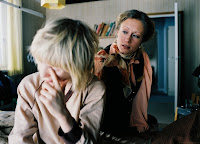 y. When Eli says at the beginning of the film, “I’m not a girl,” we naturally assume she means she’s a vampire. Is it possible she means something else? And if so, how does that change the dynamic of their interactions? A brief screen shot of Eli’s scarred genitalia forces us to ask these questions. Ultimately, the shot reminds us that Eli will forever remain as she is, an outcast in a child’s body, while Oskar will grow up, perhaps even grow out of his current status as “other.”
y. When Eli says at the beginning of the film, “I’m not a girl,” we naturally assume she means she’s a vampire. Is it possible she means something else? And if so, how does that change the dynamic of their interactions? A brief screen shot of Eli’s scarred genitalia forces us to ask these questions. Ultimately, the shot reminds us that Eli will forever remain as she is, an outcast in a child’s body, while Oskar will grow up, perhaps even grow out of his current status as “other.”
Let the Right One In takes a story about a vampire and makes it sweet, and in the end, takes that sweetness and turns it right on its head. Many people won’t read the ending as so dark, and I can see how one might even interpret it as a happy ending. But everything that comes before: Eli’s incessant quest for blood, Oskar’s increasing reliance on her strength and approval, their shared loneliness, and each character’s saving of the other’s life (both literally and metaphorically), frames the final scene (and possibly the entire film) as much more sinister than sweet.
One has to 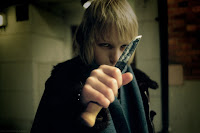 wonder if Oskar has any real idea about what’s in store for him by running away with Eli. In the end, Eli needs a new familiar, a human who will actively kill for her. While I believe Eli consciously manipulates Oskar by playing on his vulnerability, I don’t necessarily think Oskar, as naïve as he may come across to Eli, is unaware of Eli’s plan for him. It’s an exchange of sorts, and it’s about need—Oskar’s need to feel unconditionally accepted by someone, and Eli’s very practical need for blood. But it’s the film’s interrogation of “the monster within the human,” that works so well, ultimately positioning the weak, fear-based (and sympathetic) hero as the monster, a transformation that Oskar, unlike Eli, accepts willingly.
wonder if Oskar has any real idea about what’s in store for him by running away with Eli. In the end, Eli needs a new familiar, a human who will actively kill for her. While I believe Eli consciously manipulates Oskar by playing on his vulnerability, I don’t necessarily think Oskar, as naïve as he may come across to Eli, is unaware of Eli’s plan for him. It’s an exchange of sorts, and it’s about need—Oskar’s need to feel unconditionally accepted by someone, and Eli’s very practical need for blood. But it’s the film’s interrogation of “the monster within the human,” that works so well, ultimately positioning the weak, fear-based (and sympathetic) hero as the monster, a transformation that Oskar, unlike Eli, accepts willingly.
